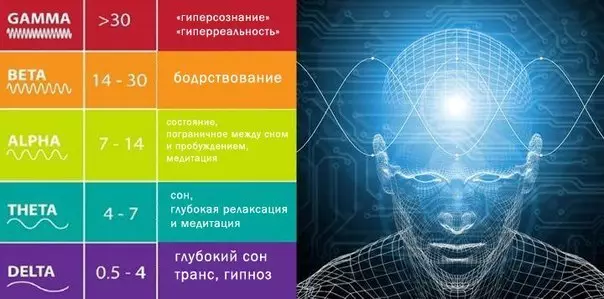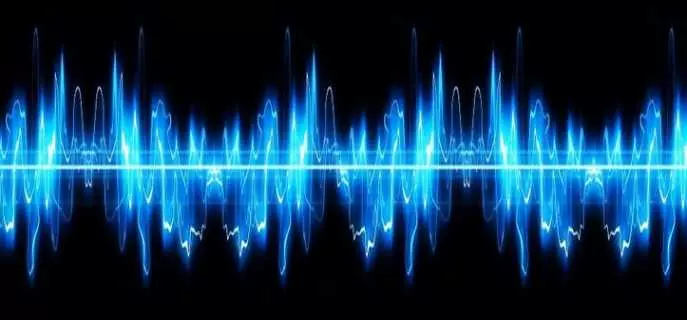Biological rhythms (in reducing biorhythms) originate from the Greek words BIOS - "Life" and Rythmos - "Any movement that is repeated, rhythm" and perform periodically repeated changes in nature, as well as the intensity of various biological phenomena and processes. Biorhythms are a fundamental process of wildlife.
In this material I suggest to talk about human biorhythms and their features, separately examining the biorhythms of the brain.

General information about biorhythms
Find out what awaits you today - a horoscope for today for all zodiac signsBy numerous subscribers requests, we have prepared an accurate horoscope application for a mobile phone. Forecasts will come for your zodiac sign every morning - it is impossible to miss!
Download free: Horoscope for every day 2020 (Available on Android)
Everything around us is subject to certain rhythms: it is for them who live people, inhabitants of animal and plant world, as well as land and even space.
We all possess our biological clock, thanks to which we live on specific natural cycles. The day regularly replaced at night, alternate all seasons of the year, the Earth turns around the Sun - all this refers to biological rhythms.
In this case, all biorhythms have their own period, the frequency of rhythms, phase and amplitude. They differ duration. You can highlight a number of cycles, namely:
- High-frequency - their duration does not exceed half an hour;
- average frequencies - vary from half an hour before the day, from 20 to 28 hours and from 29 hours to 6 days;
- Low frequencies - their frequency is 7 days, 20 days, 30 days and 1 year.
Man biorhythms: what are there
The human body has a whole set of rhythmic functions, as well as processes. The latter are connected to a single oscillatory system consistent in the time framework. This system has such features:
- Rhythms of various processes are associated with each other;
- Those or other rhythms are synchronous or painted relative to each other;
- There is a hierarchy (that is, some rhythms are subject to others).
In the human body, everything is functioning on rhythms: at the level of internal organs, cells, tissues, with metabolism, brain activity, and so on.
Scientists installed 4 basic biological rhythms (Although there are many others, but these are considered basic).
- 1.5 hour rhythms (Found about ninety-hundred minutes). During their, the neuronal activity of the brain alternates, and both in a state of activity and in a dream. It is because of this rhythm every 1.5 hours, intellectual ability to work, as well as the bioelectric activity of the brain in a dream. And therefore, after 1.5 hours we feel that increasing the excitability, performance, then, on the contrary, a decrease, a mental stupor, then peacekeeping, then anxiety.
- Daily rhythms (last 24 hours) - influence the overall condition of a person, manifest themselves with a sleep activity cycle.
- Monthly rhythms. The female organism has its monthly rhythm, according to which concrete changes occur. True, not so long ago, scientists began to talk about the presence of a monthly rhythm and from representatives of a strong gender, which affects their mood, disability.
- Annual rhythms. In the human body, cyclic changes occur every year when the season changes. For example, it was scientifically proven that, depending on the pore, the indicators of cholesterol and hemoglobin varies; Muscle excitability increases to the spring-summer season, declining to the autumn-winter; Eyes show the greatest sensitivity to the light in the spring and early summer, and to the autumn-winter season this indicator is reduced.
Of course, this is not all rhythms. In addition, there are many others, for example, social rhythms, to which a person from childhood is adapted, living in society. For example, there is a weekly rhythm. When 5 days a week, the average person spends at work, and 2 days - devotes to rest. Weekly rhythm is not natural, but provoked by social factors. Today, it is a scale of human and society life assessment scale. In this rhythm there is a change in ability to work.

Interestingly, but the same indicators are inherent in different categories of the population - different ages, the nature of the work: whether it is about the worker at the factory, teacher in a university or student, schoolboy. For weekly rhythm, it is characteristic that the lowest working capacity is observed on Monday, in the period from Tuesday to Thursday - activity as much as possible, and on Friday and on the weekend it decreases again.
Of course, not all people in the world work on weekly biorhythms, there are other working conditions. The body is able to adapt to various working graphics.
In addition, there are individual physical, emotional and intellectual rhythms. Now it is possible to calculate biorhythms online on the Internet.
Why need biorhythms
Biological rhythms are performed in the human body, at least 4 the following functions:- Reflect the time factor. With the help of biological rhythms, an objective, astronomical time is converted to subjective, biological. It is necessary in order to make it possible to relate the cycles of life processes with real-time cycles.
- Perform a regulatory function. Thanks to the biorhythms, functional systems are created in the central nervous system (abbreviations to designate the central nervous system), as well as various functions.
- Perform an integration (combining) function. Biorhythms are a workflow, which combines all levels of body organization, making them a single supersystem. At the same time, hierarchy takes place: so high frequency rhythms are subordinate to the rhythms of medium and low frequency of higher levels. If you explain more clearly: biological rhythms of cells, fabrics, organs, various systems are subordinate to the mid-frequency daily rhythm
- Optimize the vital activity of the body. In order for any biosystem to function correctly, cyclicity must be observed. It is due to the fact that a specific biological process cannot continue with the same intensity for a long time. A contrast, processes change their activity from maximum to minimal. This is important, since the change in the degree of activity into specific phases of each of the cycle periods allows to save more energy than if such a maximum continued continuously. Therefore, in any biosystem, the period of activity is replaced by the recovery period of the accumulation of new energy (and man is no exception to the rules) .
Brain biorhythms
Now let's stay in more detail on such a complex organ of the human body as a brain.

You probably know that the human brain uses electrical signals. It is carried out by an infinite process of generating electrical pulses (that is, brain waves or brain rhythms). The frequency of the pulse data is fixed in Hertz (abbreviated Hz) or cycles per second. And according to the dominant frequency of the rhythms of the brain, you can judge its condition as a whole.
Why is it talking about "dominant" frequency? The human brain does not function only on one of the frequencies. Accordingly, when in one part it is made, for example, beta waves, then alpha or gamma waves may arise into another. And because of what a person seems to be in a state of absolute calm, but in some of the parts of the brain in the background, obsessive thoughts are spinning about urgent difficulties, stress.
Scientists allocate only 6 main varieties of rhythms (waves) of brain activity. Let's look at all of them in more detail and find out why they need them.
Alpha Rhythms
The frequency of their oscillation varies from 8-13 Hertz per second. Alpha Rhythms are inherent from 85 to 95 percent of healthy adults. The backbone is dominated.
The largest amplitude of these rhythms falls on the state of calm activity, especially if the person has eyes closed, it is in a native room. In this regard, they are often used in meditative practices, hypnosis.
And weaker alpha rhythms are blocked, when attentiveness increases (especially visual), mental activity. In most cases, alpha rhythms completely disappear with the opening of the eyes when a person sees a real picture.
Alpha Rhythm is the process of internal reproduction of thinking, when the overall attention is occupied by the resolution of a particular intellectual task.
People who have clearly manifested alpha rhythms are prone to abstract thinking. But there are those who have the rhythms of this spectrum are completely absent, even if they close their eyes. The latter with ease operate with visual pictures, but with difficulty decide abstract problems.
Those lucky people who know how to perform an analysis of the information when their brain is configured to alpha rhythms, successfully cope with large amounts of information, they are more often creative inspiration, the sixth sense becomes stronger. Thanks to all this, they easily find faithful (truth, often unexpected) difficulties.

When the brain is working on alpha rhythms, it increases the possibility of a person to independently control his life. He realizes how it is more correct to solve those or other problems, learns to rebuild his psyche so that the goals have been achieved, and the dreams became real.
Interesting fact. When the brain is configured to alpha rhythms, we fall into the surface meditative state. The same is the case at the reception of a hot bath or soul.
Beta rhythms
The frequency of their oscillations varies from 14 to 40 Hertz per second. Registered in the area of the front and central convulsions, can reach the rear central.Beta-rhythm is manifested in a state of activity. It becomes stronger when an unexpected stimulus arises when a person must show attentiveness to work mentally either be in a state of emotional arousal.
Being at the frequency of beta rhythms, the brain turns out to be in everyday life, forced to solve various daily difficulties, to deal with stress factors, actively concentrate on something. At the same time, all the attention is directed to the outside world.
It is using beta-rhythms that people were able to come up with technical inventions: to build megalopolises, create a TV, Internet, fly to space, thanks to them, medicine also developed. Beta rhythm is associated with active creation, real life.
Gamma Rhythms
The frequency of their oscillation exceeds 30 hertz per second, can reach up to 100 hertz. Gamma rhythms are characteristic of solving complex tasks when it is necessary to fully focus their attention on the problem. According to a number of scientific theories, these rhythms have a relationship with consciousness. Some experts believe that schizophrenia patients have different violations of the activity of gamma rhythms.
But gamma rhythms are not limited to intellectual activity, they will also relate to the state of communicating a person with their subconscious. For example, researchers studied Buddhist meditating and found that their brain operates at 50 hertz, which is tantamount to the so-called "enlightenment".

Delta Rhythms
Their frequency varies from 1 to 4 hertz per second. Delta rhythm is manifested in a state of deep natural sleep, as well as a narcotic or coma state. Related to recovery processes. In the case of many neurological pathologies, there is a noticeable increase in delta waves.Interesting fact. Delta Rhythm is characteristic of the deep state of meditation (Dhyana). This is not just a relaxation, as at the level of alpha rhythm, but something deeper.
Teta Rhythms
The frequency varies from 4 to 8 hertz. The strongest of the Teta Rhythms are manifested in children in the age group from 2 to 5 years. Theta waves provide deep relaxation of the brain, excellent memory, the process of deeper and fast absorption of information, activation of creative abilities.
As a rule, children under 5 years old are subject to this brain biorhythm. Thanks to which they with ease remember a huge number of new information that teenagers or adults cannot do.
As for adults, they normally, they have theta rhythms only in the rapid sleep phase, in a state of half a lot. And while diving into deep meditation-dhyun.
In the theta range of the brain has enough energy to process a large information volume, as well as transfer knowledge to long-term memory. The activation of mental activity occurs, the impact of stress is reduced. The brain is more susceptible.
Sigma Rhythms
Their frequency varies from 10 to 16 hertz, but, as a rule, equals 12-14 fluctuations in a second. Sigma rhythms are distinguished by spontaneity, spine-like activity. Explosive or flare activity, which was recorded in a state of sleep, both natural and can appear under the influence of various drugs, for example, during operational interventions.
Sigma Rhythms usually arise at the initial stages of slow sleep preceding the nap. But in the process of sleep, with the participation of Delta waves, the sigma rhythms practically do not appear. In people, the rhythms of this spectrum first appear at the age of 3 months, subsequently the frequency of their changes remains unchanged.
Finally, browse the video on the topic:
